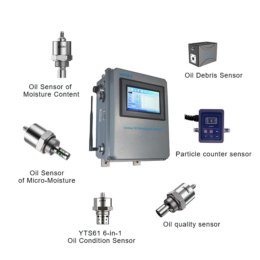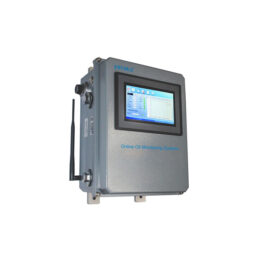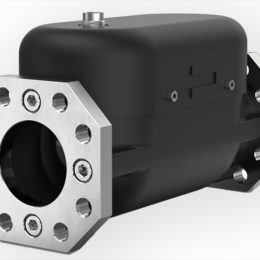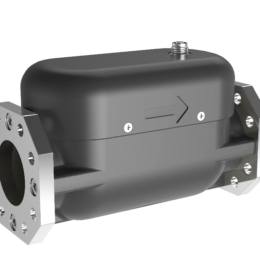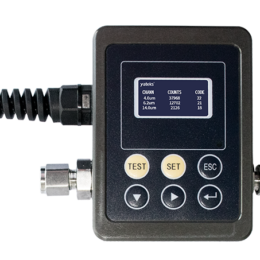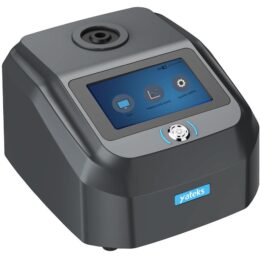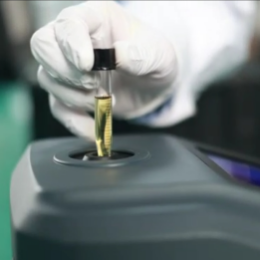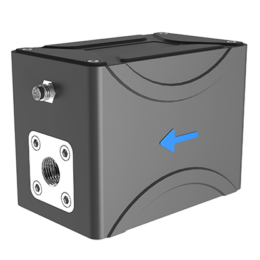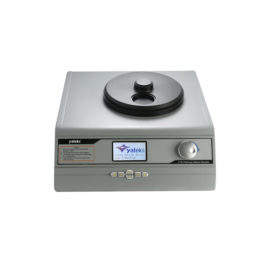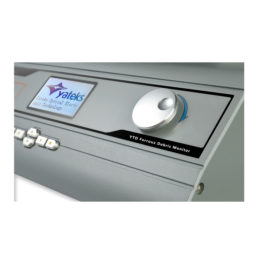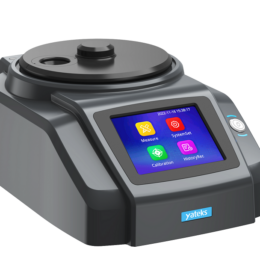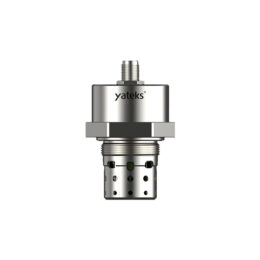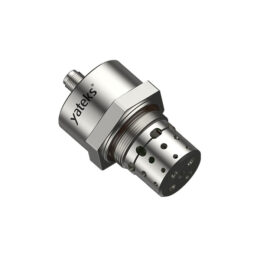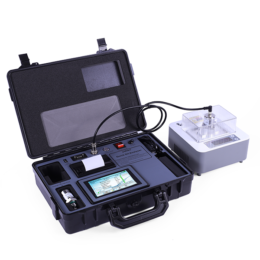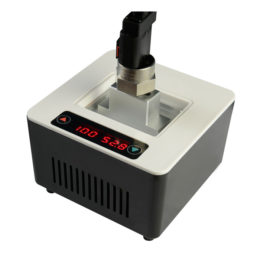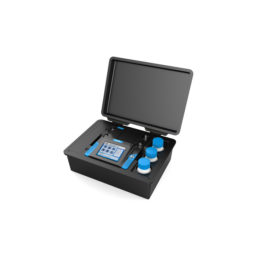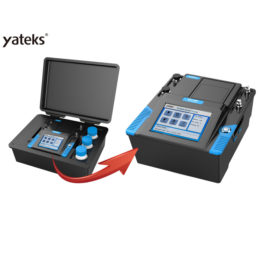Oil Analysis Equipment
The onsite oil analysis equipment is used to detect the lube oil. An oil analysis system can catch the physical and chemical performance of the oil. The oil test machine performs very well in terms of testing to wear metal and contaminant particles.
The first step is to know about the equipment’s lubricating and wear state. The onsite oil analysis equipment is used to diagnose the abrasive wear type, position, and cause. The condition monitoring system can provide the scientific basis of equipment repair. The oil analysis system can help your company find out the equipment state repair. With the help of the oil analysis system, you will know how to do lubricating management. If you use an oil analysis system to prevent the industrial equipment major accident, the cost of repairing will decrease a lot.
Yateks condition monitoring system and oil analysis system have a high quality and lower price. The condition monitoring system can help your oil testing instrument used in engine oil analysis, lube oil analysis, motor oil test, oil sample analysis, engine oil testing. Here is the best oil analysis system for you.
- Standardization of non-standard products
- Modular design
- Wide range of detection
- Tele-diagnosis
- 40μm ferromagnetic & 150μm non-ferromagnetic wear particles detection capability;
- Abrasion particle quantity statistics and material analysis;
- Abnormal wear monitoring to safeguard valuable assets;
- Adop light blockage method (photoresistance method) principle
- It could be calibrated as ISO4402 or ISO11171
- With standard serial RS485 interface
- Grasp and analyze the real-time data and hydraulic system wear trend
- YPA-TTL2 provides an accurate, easy-to-use solution for offline and at-line measurements of ferrous wear debris concentrations.
- YPA-TTL2 is a standalone tester and helpful to analyzes a small sample of oil for ferrous debris.
- YPA-TTL2 features rapid and simple operation, outstanding sensitivity, is a perfect complement to any on-side or laboratory oil analysis.
- The full range detection rate is not less than 80%
- The outer casing is made of aluminum alloy, the surface is hard oxidized, the structure is light
- Small structure, easy system integration, on-site calibration of integrated modules
- Comply with CE, ASTM1657 and other certification and testing standards
- With patent sensor and signal processing technology
- Matched PC software for data analysis
- Easy operation for calibration and measurement
- Self-calibrate, easy operate and no need training
- High sensitive on wear debris particles >1um;
- Quick analysis and test result in 10 seconds;
- Can be used for lubricating oil and grease analysis
- Imported probes, accurate measurement of viscosity, density and temperature up to six parameters output online monitoring sensor;
- Fast response, the data refresh frequency every second;
- The outer casing is made of stainless steel and has excellent chemical and pressure resistance.
- Adopting the plate type oil sensor
- Portable design and convenient operation
- Available for on-site and field work
- YJS-150 oil particle count meter adopting the light blockage method
- On-site testing range: 1μm~400μm
- High precision and repeatability
Oil analysis technology has developed rapidly in the past ten years, and various small, comprehensive, and cost-effective on-site oil analysis equipment have appeared. Just as the human body can provide important health information through blood testing, on-site oil analysis equipment can provide machine health information. Unlike commercial laboratories, on-site oil analysis equipment does not require large laboratory space, hazardous material handling, IT infrastructure, special skills, and additional personnel. The entire oil analysis process only takes a few minutes. Through the on-site oil analysis equipment, the engine or gearbox's wear and oil condition information can be obtained in time.
An analysis report of on-site oil analysis equipment contains more than 30 parameters, including engine wear metals, corrosion, pollution (such as water), coolant or fuel, and oil condition. Compared with other predictive maintenance technologies such as vibration analysis and thermal imaging, on-site oil analysis equipment provides much more information. On-site oil analysis equipment is used to perform critical tasks, such as military aerospace and F1 racing. As a tool, on-site oil analysis equipment can protect the engine. In the field of military aerospace, on-site oil analysis equipment is also necessary, and an analysis report must be provided as soon as possible within a few hours after receiving the flight instruction. Sometimes, the pilot waits for the analysis report next to the on-site oil analysis equipment.
Oil monitoring equipment is mainly used to monitor the consumption of lubricating oil and abrasives. Oil monitoring is the primary work of equipment lubrication management and maintenance and the main method to improve equipment reliability and ensure the equipment operation safety.
Oil monitoring equipment regularly checks the lubricant's physical and chemical properties, the wear of metals and pollutant particles. Understand the equipment's lubrication and wear status to diagnose the type, location, and cause of abrasive wear. In this way, it provides a scientific basis for equipment maintenance, guides the company's equipment maintenance and lubrication management, prevents significant equipment failures, and reduces maintenance costs.
Lubricant analysis condition monitoring is a kind of equipment early warning technology. The lubricant analysis condition monitoring system is often used in mechanical equipment and can also perform fault diagnosis and prognosis under condition-based maintenance. Since sufficient information can be obtained from lubricant testing, lubricant analysis condition monitoring technology is widely used in equipment monitoring. It proves an introspective reflection on the state and state of machines and lubricants. The mature lubricant analysis condition monitoring system uses various technologies and methods to extract, process, and analyze information to provide decision support. Implementing a lubricant analysis condition monitoring program can significantly reduce the maintenance cost of the machine and improve the reliability and safety of the factory.
The most significant advantage of using a condition monitoring system is that the machine maintenance costs can be reduced. How to explain this advantage that the oil condition monitoring brings? First of all, we assume such a situation, and our oil equipment has never been tested. Theoretically speaking, oil equipment begins to age naturally from the first day of use. Various harsh natural conditions will also accelerate the wear and tear of equipment. In this case, we can't know the equipment's wear status by looking at the appearance. What happens if the device has never been tested during use? We don't see the equipment is ageing or damaged. Then this state of wear will gradually increase. When we discovered that the equipment was malfunctioning, it was too late.
The severity of equipment failure has reached a level beyond our control. At this time, the cost of repairing equipment will be very high. In the worst case, the equipment's damage may not be repaired well and replace with the new one. The cost of replacing new equipment is much greater than repairing it.
What happens if we use lube oil analysis for regular maintenance of the equipment? When it is put into use for a new machine, its ageing and damage are very slow. The first cycle checked with it can be one year or two years. Supposing that, we set the first inspection time of new equipment to be one year later. We use the portable particle counter to detect the wear status of oil equipment. We can know the wear status of the equipment. We can see the usage of the machine this year.
If the machine is found to be completely free from wear during the first inspection, then we can determine the date of the following review of the equipment. The next time can be one year or six months. Half a year later, we used the oil test machine to recheck the equipment and found a slight wear condition. At this time, we can take simple maintenance measures. We can find out the cause of equipment wear. After seeing the reason, when using the device, change the inappropriate behaviour during use. When we take these measures, the cost of equipment maintenance will be greatly reduced.
First of all, we have to understand the situation. The impact of the condition monitoring service on the production volume is indirect rather than direct. The condition monitoring system can help you increase production. How to explain this advantage? If your equipment is not repaired for a long time, there will be many serious problems. One of the severe consequences is production delays. When the equipment fails, it cannot be used usually, and the equipment will stop running. It is conceivable that a lot of work is lost every day. However, when we use the condition monitor to regularly check the machine, we can repair minor equipment problems quickly. In this way, the kit will not stop running. The production volume has reached its maximum.
The oil condition monitoring can extend the service life of the machine. When the engine is checked regularly, minor problems are found and resolved. The service life of the appliance is naturally increased. How to explain this situation? We can assume that a piece of equipment has not been repaired since it was put into use until it broke down. Then the service life of the equipment can be concise.
On the contrary, if we use it to check the operation of the equipment regularly, what will be different? The most significant difference is that we can grasp the operation of the equipment in real-time. We use it to detect problems and fix them immediately. The result of this is that the equipment will continuously operate in good condition, and with its help, the machine's service life will be prolonged.
With the help of the condition monitoring system, you can determine the priority of equipment maintenance. Maybe you are responsible for the operation and keeping of a lot of equipment. How to pick the order of equipment maintenance? At this time, the help of oil condition monitoring is needed. When you use oil condition monitoring, you have a clear grasp of all the mechanical equipment. You know the extent of damage to each piece of equipment very well. Next, determine the maintenance sequence according to the degree of mechanical damage. Priority maintenance is given to machinery with severe damage. Your work will become orderly.

